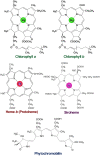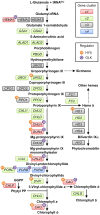Transcriptional Regulation of Tetrapyrrole Biosynthesis in Arabidopsis thaliana
- PMID: 27990150
- PMCID: PMC5130987
- DOI: 10.3389/fpls.2016.01811
Transcriptional Regulation of Tetrapyrrole Biosynthesis in Arabidopsis thaliana
Abstract
Biosynthesis of chlorophyll (Chl) involves many enzymatic reactions that share several first steps for biosynthesis of other tetrapyrroles such as heme, siroheme, and phycobilins. Chl allows photosynthetic organisms to capture light energy for photosynthesis but with simultaneous threat of photooxidative damage to cells. To prevent photodamage by Chl and its highly photoreactive intermediates, photosynthetic organisms have developed multiple levels of regulatory mechanisms to coordinate tetrapyrrole biosynthesis (TPB) with the formation of photosynthetic and photoprotective systems and to fine-tune the metabolic flow with the varying needs of Chl and other tetrapyrroles under various developmental and environmental conditions. Among a wide range of regulatory mechanisms of TPB, this review summarizes transcriptional regulation of TPB genes during plant development, with focusing on several transcription factors characterized in Arabidopsis thaliana. Key TPB genes are tightly coexpressed with other photosynthesis-associated nuclear genes and are induced by light, oscillate in a diurnal and circadian manner, are coordinated with developmental and nutritional status, and are strongly downregulated in response to arrested chloroplast biogenesis. LONG HYPOCOTYL 5 and PHYTOCHROME-INTERACTING FACTORs, which are positive and negative transcription factors with a wide range of light signaling, respectively, target many TPB genes for light and circadian regulation. GOLDEN2-LIKE transcription factors directly regulate key TPB genes to fine-tune the formation of the photosynthetic apparatus with chloroplast functionality. Some transcription factors such as FAR-RED ELONGATED HYPOCOTYL3, REVEILLE1, and scarecrow-like transcription factors may directly regulate some specific TPB genes, whereas other factors such as GATA transcription factors are likely to regulate TPB genes in an indirect manner. Comprehensive transcriptional analyses of TPB genes and detailed characterization of key transcriptional regulators help us obtain a whole picture of transcriptional control of TPB in response to environmental and endogenous cues.
Keywords: Arabidopsis thaliana; chlorophyll; chloroplast; gene expression; heme; photosynthesis; porphyrin; tetrapyrrole.
Figures





Similar articles
-
Regulation and function of tetrapyrrole biosynthesis in plants and algae.Biochim Biophys Acta. 2015 Sep;1847(9):968-85. doi: 10.1016/j.bbabio.2015.05.007. Epub 2015 May 12. Biochim Biophys Acta. 2015. PMID: 25979235 Review.
-
Post-translational regulation of metabolic checkpoints in plant tetrapyrrole biosynthesis.J Exp Bot. 2022 Aug 11;73(14):4624-4636. doi: 10.1093/jxb/erac203. J Exp Bot. 2022. PMID: 35536687 Free PMC article. Review.
-
FLU: a negative regulator of chlorophyll biosynthesis in Arabidopsis thaliana.Proc Natl Acad Sci U S A. 2001 Oct 23;98(22):12826-31. doi: 10.1073/pnas.221252798. Epub 2001 Oct 16. Proc Natl Acad Sci U S A. 2001. PMID: 11606728 Free PMC article.
-
Regulatory and retrograde signaling networks in the chlorophyll biosynthetic pathway.J Integr Plant Biol. 2025 Apr;67(4):887-911. doi: 10.1111/jipb.13837. Epub 2025 Jan 24. J Integr Plant Biol. 2025. PMID: 39853950 Free PMC article. Review.
-
Methods for analysis of photosynthetic pigments and steady-state levels of intermediates of tetrapyrrole biosynthesis.Methods Mol Biol. 2011;775:357-85. doi: 10.1007/978-1-61779-237-3_20. Methods Mol Biol. 2011. PMID: 21863454
Cited by
-
The retrograde signaling protein GUN1 regulates tetrapyrrole biosynthesis.Proc Natl Acad Sci U S A. 2019 Dec 3;116(49):24900-24906. doi: 10.1073/pnas.1911251116. Epub 2019 Nov 15. Proc Natl Acad Sci U S A. 2019. PMID: 31732672 Free PMC article.
-
Comprehensive Comparative Analysis of the GATA Transcription Factors in Four Rosaceae Species and Phytohormonal Response in Chinese Pear (Pyrus bretschneideri) Fruit.Int J Mol Sci. 2021 Nov 19;22(22):12492. doi: 10.3390/ijms222212492. Int J Mol Sci. 2021. PMID: 34830372 Free PMC article.
-
Vacuolar Iron Stores Gated by NRAMP3 and NRAMP4 Are the Primary Source of Iron in Germinating Seeds.Plant Physiol. 2018 Jul;177(3):1267-1276. doi: 10.1104/pp.18.00478. Epub 2018 May 21. Plant Physiol. 2018. PMID: 29784767 Free PMC article.
-
NTRC and TRX-f Coordinately Affect the Levels of Enzymes of Chlorophyll Biosynthesis in a Light-Dependent Manner.Cells. 2023 Jun 20;12(12):1670. doi: 10.3390/cells12121670. Cells. 2023. PMID: 37371140 Free PMC article.
-
Dual plastid targeting of protoporphyrinogen oxidase 2 in Amaranthaceae promotes herbicide tolerance.Plant Physiol. 2024 Apr 30;195(1):713-727. doi: 10.1093/plphys/kiae062. Plant Physiol. 2024. PMID: 38330186 Free PMC article.
References
-
- Albus C. A., Salinas A., Czarnecki O., Kahlau S., Rothbart M., Thiele W., et al. (2012). LCAA, a novel factor required for magnesium protoporphyrin monomethylester cyclase accumulation and feedback control of aminolevulinic acid biosynthesis in tobacco. Plant Physiol. 160 1923–1939. 10.1104/pp.112.206045 - DOI - PMC - PubMed
Publication types
LinkOut - more resources
Full Text Sources
Other Literature Sources
Molecular Biology Databases

